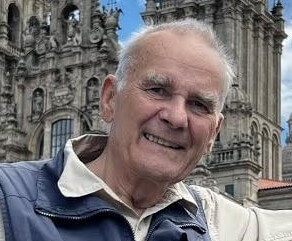A loving tribute to John Brierley, author of the most popular English-language Camino guidebook
From Johnniewalker Santiago, shared with permission
Introduction
I first met John Brierley when I interviewed him for my blog in Clapham, London in May 2010. We became firm friends and the friendship lasted until his death.
A husband, father, and former chartered surveyor he became the best known name in the English language world of the Camino de Santiago through his best-selling guidebooks.
John was much more than a successful guidebook writer: he was a visionary and an inspiration to me and tens of thousands of other pilgrims. It is little known that he was also a philanthropist donating considerable amounts of the profits of his books. As a visionary he could see where the Camino could be developed. This is an important part of his legacy which comes at the end of this story.
John believed that the Camino experience could transform individuals for the better and they in turn could transform our broken world.
Above all he was a gentleman – gentle and kind.
Over the next days I’ll post that interview and tell you his story including how he inspired 1600 messages of love from his fellow pilgrims when it became known he was gravely ill.
Part One
Monday, 31 May 2010
John Brierley and the Inner Journey
John Brierley, author of best selling Camino Guides, is one of the most well known names in the Camino world. In the last seven years over 40,000 of his guides to the Caminos Francés, Portugués, and the route to Finisterre have been sold. His books are guides to what he calls the “inner and outer journeys” and as well as route information they contain notes on the “mystical path” and encourage self review and reflection. This aspect of John’s work is not universally popular among pilgrims, many of whom simply want information on where to walk and where to sleep and so I was very interested in meeting the man behind the book cover.
I wrote to John asking if I could talk to him and he readily agreed, stopping off to meet me on his way to lunch with a relative. It was just like meeting another pilgrim on the Camino. Within seconds the social niceties were over and we were into deep conversation. John was animated from the start, his eyes alive with an evangelical conviction for what he says. His life story is vivid and he told it in a soft voice still coloured with the accent of his native Dublin where almost 40 years ago he practised as a chartered surveyor.
By the mid 1980’s he was to all appearances successful. He was married with two children, lived in a detached house in the suburbs, ran his own company and was in his own words, “materialistic and chauvinistic”. In 1986 at the age of 39 John became increasingly aware of an emptiness in his life as he asked himself the question, “what is all this for?” He described a recurring daydream, his very own “ghost of Christmas Yet To Come” which showed him the meaninglessness of his life.
To prepare for my conversation with him I had read some of John’s story on his website and I was even more intrigued. I put it to John that many people at the age of 40 have these feelings of restless emptiness but that is a world away from up-rooting the family, selling everything, and living in a camper van. How did it come about?
John described a year of having the daydream but was so “spiritually blind” he didn’t know what to do about it. He decided to follow the fashion of the day and have a sabbatical. He wanted to make it a real break so they sold the house and set off travelling. He described it as just like going on pilgrimage and the act of “taking time out” was what grew into a lifelong spiritual search. On the last day of his year out he resigned from his firm. He realised that the journey he was on was not geographic but spiritual and for the last part of the year he and the family and settled down in the spiritual community at Findhorn in Scotland.
When they were on their travels they parked the camper van in the car park at Saint Jean Pied de Port and looking out they saw pilgrims starting the Camino over the Pyrenees to Spain. Wanting to find out more about the Camino they drove along the Way stopping in Roncesvalles, Pamplona, and other places en route. When they stopped they spoke to pilgrims and got some sense of what it was about. This was the first time John had heard about the pilgrimage routes to Santiago de Compostela. The seed was sown but it was to be another two years before he packed a rucksack and walked the Camino Francés for the first time.

